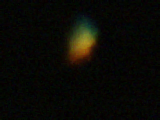My postings are lagging a bit behind with respect current events, but I still wanted to share this image of Venus taken December 29th, around two weeks before inferior conjunction:
As can be seen, the crescent is getting quite thin now. Of course, by now it is actually even thinner, see for example http://www.universetoday.com/107663/astro-challenge-nabbing-venus-at-inferior-conjunction/.
Speaking of crescents, there was a New Moon on January 1st and I got some images of the very young Moon on January 2nd. These were all taken with the small Galileoscope to make the entire Moon fit on the camera chip. Here is an image of the crescent itself:
If you look carefully you can discern some details of the lunar surface. I also happened to serendipitously catch an airplane in the act of traversing the image. Here is an animated GIF of the unprocessed frames:
A nice bonus this is. However, my actual goal for the evening was to shoot my first Earthshine image. The “unlit” portion of the Moon is actually faintly illuminated by reflected light from the Earth, and can be made visible using longer exposures:
I’m quite happy with the way this turned out.

















